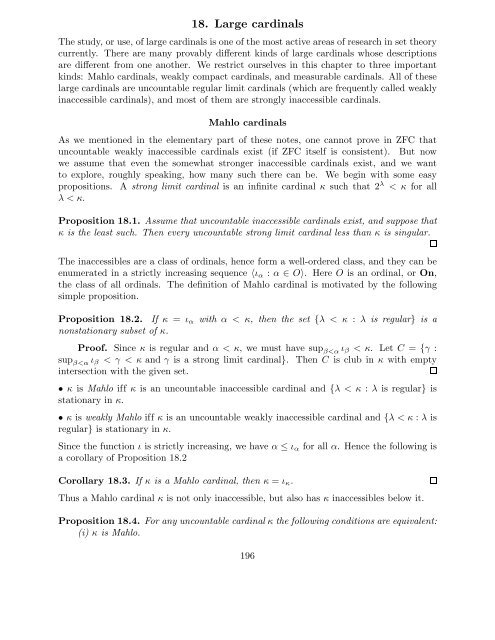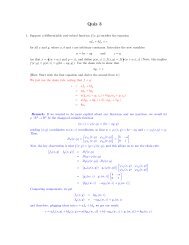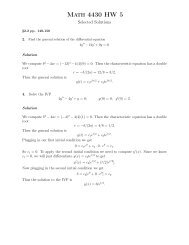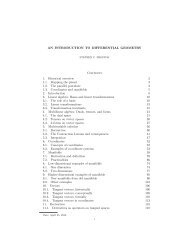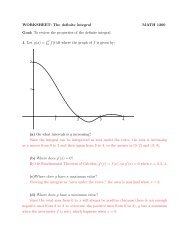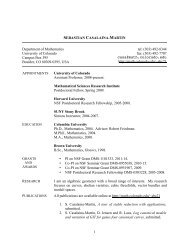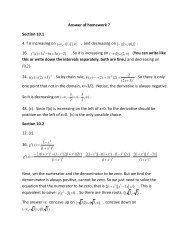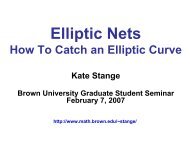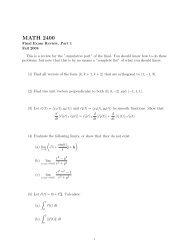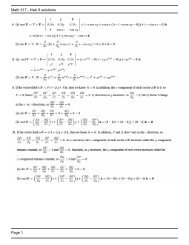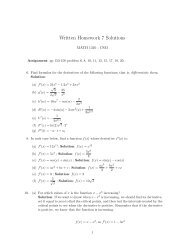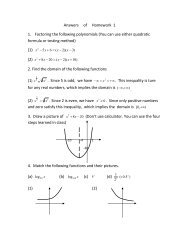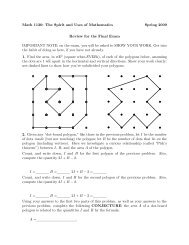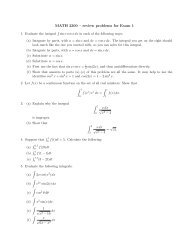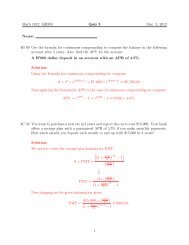18. Large cardinals
18. Large cardinals
18. Large cardinals
Create successful ePaper yourself
Turn your PDF publications into a flip-book with our unique Google optimized e-Paper software.
<strong>18.</strong> <strong>Large</strong> <strong>cardinals</strong><br />
The study, or use, of large <strong>cardinals</strong> is one of the most active areas of research in set theory<br />
currently. There are many provably different kinds of large <strong>cardinals</strong> whose descriptions<br />
are different from one another. We restrict ourselves in this chapter to three important<br />
kinds: Mahlo <strong>cardinals</strong>, weakly compact <strong>cardinals</strong>, and measurable <strong>cardinals</strong>. All of these<br />
large <strong>cardinals</strong> are uncountable regular limit <strong>cardinals</strong> (which are frequently called weakly<br />
inaccessible <strong>cardinals</strong>), and most of them are strongly inaccessible <strong>cardinals</strong>.<br />
Mahlo <strong>cardinals</strong><br />
As we mentioned in the elementary part of these notes, one cannot prove in ZFC that<br />
uncountable weakly inaccessible <strong>cardinals</strong> exist (if ZFC itself is consistent). But now<br />
we assume that even the somewhat stronger inaccessible <strong>cardinals</strong> exist, and we want<br />
to explore, roughly speaking, how many such there can be. We begin with some easy<br />
propositions. A strong limit cardinal is an infinite cardinal κ such that 2 λ < κ for all<br />
λ < κ.<br />
Proposition <strong>18.</strong>1. Assume that uncountable inaccessible <strong>cardinals</strong> exist, and suppose that<br />
κ is the least such. Then every uncountable strong limit cardinal less than κ is singular.<br />
The inaccessibles are a class of ordinals, hence form a well-ordered class, and they can be<br />
enumerated in a strictly increasing sequence 〈ι α : α ∈ O〉. Here O is an ordinal, or On,<br />
the class of all ordinals. The definition of Mahlo cardinal is motivated by the following<br />
simple proposition.<br />
Proposition <strong>18.</strong>2. If κ = ι α with α < κ, then the set {λ < κ : λ is regular} is a<br />
nonstationary subset of κ.<br />
Proof. Since κ is regular and α < κ, we must have sup β
(ii) {λ < κ : λ is inaccessible} is stationary in κ.<br />
Proof. (i)⇒(ii): Let S = {λ < κ : λ is regular}, and S ′ = {λ < κ : λ is inaccessible}.<br />
Assume that κ is Mahlo. In particular, κ is uncountable and inaccessible. Suppose that<br />
C is club in κ. The set D = {λ < κ : λ is strong limit} is clearly club in κ too. If<br />
λ ∈ S ∩ C ∩ D, then λ is inaccessible, as desired.<br />
(ii)⇒(i): obvious.<br />
The following proposition answers a natural question one may ask after seeing Corollary<br />
<strong>18.</strong>3.<br />
Proposition <strong>18.</strong>5. Suppose that κ is minimum such that ι k = κ. Then κ is not Mahlo.<br />
Proof. Suppose to the contrary that κ is Mahlo, and let S = {λ < κ : λ is<br />
inaccessible} For each λ ∈ S, let f(λ) be the α < κ such that λ = ι α . Then α = f(λ) < λ<br />
by the minimality of κ. So f is regressive on the stationary set S, and hence there is an<br />
α < κ and a stationary subset S ′ of S such that f(λ) = α for all λ ∈ S ′ . But actually f is<br />
clearly a one-one function, contradiction.<br />
Mahlo <strong>cardinals</strong> are in a sense larger than “ordinary” inaccessibles. Namely, below every<br />
Mahlo cardinal κ there are κ inaccessibles. But now in principle one could enumerate all<br />
the Mahlo <strong>cardinals</strong>, and then apply the same idea used in going from regular <strong>cardinals</strong> to<br />
Mahlo <strong>cardinals</strong> in order to go from Mahlo <strong>cardinals</strong> to higher Mahlo <strong>cardinals</strong>. Thus we<br />
can make the definitions<br />
• κ is hyper-Mahlo iff κ is inaccessible and the set {λ < κ : λ is Mahlo} is stationary in κ.<br />
• κ is hyper-hyper-Mahlo iff κ is inaccessible and the set {λ < κ : λ is hyper-Mahlo} is<br />
stationary in κ.<br />
Of course one can continue in this vein.<br />
Weakly compact <strong>cardinals</strong><br />
• A cardinal κ is weakly compact iff κ > ω and κ → (κ, κ) 2 . There are several equivalent<br />
definitions of weak compactness. The one which justifies the name “compact” involves<br />
infinitary logic, and it will be discussed later. Right now we consider equivalent conditions<br />
involving trees and linear orderings.<br />
• A cardinal κ has the tree property iff every κ-tree has a chain of size κ.<br />
Equivalently, κ has the tree property iff there is no κ-Aronszajn tree.<br />
• A cardinal κ has the linear order property iff every linear order (L,
Assume the linear order property, and let (T,
• z<br />
• y<br />
y • • z<br />
y • • z x • • z<br />
x •<br />
• x<br />
• x<br />
Case 1 Subcase 2.1 Subcase 2.2 Case 3<br />
x •<br />
y<br />
•<br />
z •<br />
x •<br />
y<br />
•<br />
z •<br />
x •<br />
y<br />
•<br />
z •<br />
Subcase 4.1 Subcase 4.2 Subcase 4.3<br />
We claim that B is a chain in T of size κ. Suppose that t 0 , t 1 ∈ B with t 0 ≠ t 1 , and choose<br />
x 0 , x 1 ∈ L correspondingly. Say wlog x 0 < ′′ x 1 . Now t 0 ∈ B and x 0 ≤ ′′ x 1 , so t 0 ≤ x 1 .<br />
And t 1 ∈ B and x 1 ≤ x 1 , so t 1 ≤ x 1 . So t 0 and t 1 are comparable.<br />
Now let α < κ; we show that B has an element of height α. For each t of height α let<br />
V t = {x ∈ L : t ≤ x}. Then<br />
{x ∈ L : ht(x) ≥ α} = ⋃<br />
ht(t)=α<br />
since there are fewer than κ elements of height less than κ, this set has size κ, and so there<br />
is a t such that ht(t) = α and |V t | = κ. We claim that t ∈ B. To prove this, take any<br />
x ∈ V t such that t < x. Suppose that a ∈ L and x ≤ ′′ a. Choose y ∈ V t with a < ′′ y and<br />
t < y. Then t < x, t < y, and x ≤ ′′ a < ′′ y. If x = a, then t ≤ a, as desired. If x < ′′ a,<br />
then t < a by (*).<br />
This finishes the case in which L has a subset of order type κ. The case of order type<br />
κ ∗ is similar, but we give it. So, suppose that L has order type κ ∗ . Define<br />
V t ;<br />
B = {t ∈ T : ∃x ∈ L∀a ∈ L[a ≤ ′′ x → t ≤ a]}.<br />
We claim that B is a chain in T of size κ. Suppose that t 0 , t 1 ∈ B with t 0 ≠ t 1 , and choose<br />
x 0 , x 1 ∈ L correspondingly. Say wlog x 0 < ′′ x 1 . Now t 0 ∈ B and x 0 ≤ x 0 , so t 0 ≤ x 0 . and<br />
t 1 ∈ B and x 0 ≤ ′′ x 1 , so t 1 ≤ x 0 . So t 0 and t 1 are comparable.<br />
199
Now let α < κ; we show that B has an element of height α. For each t of height α let<br />
V t = {x ∈ L : t ≤ x}. Then<br />
{x ∈ L : ht(x) ≥ α} = ⋃<br />
V t ;<br />
ht(t)=α<br />
since there are fewer than κ elements of height less than κ, this set has size κ, and so there<br />
is a t such that ht(t) = α and |V t | = κ. We claim that t ∈ B. To prove this, take any<br />
x ∈ V t such that t < x. Suppose that a ∈ L and a ≤ ′′ x. Choose y ∈ V t with y < ′′ a and<br />
t < y. Then t < x, t < y, and y < ′′ a ≤ ′′ x. If a = x, then t < a, as desired. If a < ′′ x,<br />
then t < a by (*).<br />
Theorem <strong>18.</strong>7. For any uncountable cardinal κ the following conditions are equivalent:<br />
(i) κ is weakly compact.<br />
(ii) κ is inaccessible, and it has the linear order property.<br />
(iii) κ is inaccessible, and it has the tree property.<br />
(iv) For any cardinal λ such that 1 < λ < κ we have κ → (κ) 2 λ .<br />
Proof. (i)⇒(ii): Assume that κ is weakly compact. First we need to show that κ is<br />
inaccessible.<br />
To show that κ is regular, suppose to the contrary that κ = ∑ α
(ii)⇒(iii): By Lemma <strong>18.</strong>6.<br />
(iii)⇒(iv): Assume (iii). Suppose that F : [κ] 2 → λ, where 1 < λ < κ; we want to<br />
find a homogeneous set for F of size κ. We construct by recursion a sequence 〈t α : α < κ〉<br />
of members of
so since |B| = κ it follows that |H ξ | = κ for some ξ < λ, as desired.<br />
(iv)⇒(i): obvious.<br />
Now we go into the connection of weakly compact <strong>cardinals</strong> with logic, thereby justifying<br />
the name “weakly compact”. This is optional material.<br />
Let κ and λ be infinite <strong>cardinals</strong>. The language L κλ is an extension of ordinary first<br />
order logic as follows. The notion of a model is unchanged. In the logic, we have a sequence<br />
of λ distinct individual variables, and we allow quantification over any one-one sequence<br />
of fewer than λ variables. We also allow conjunctions and disjunctions of fewer than κ<br />
formulas. It should be clear what it means for an assignment of values to the variables to<br />
satisfy a formula in this extended language. We say that an infinite cardinal κ is logically<br />
weakly compact iff the following condition holds:<br />
(*) For any language L κκ with at most κ basic symbols, if Γ is a set of sentences of the<br />
language and if every subset of Γ of size less than κ has a model, then also Γ has a model.<br />
Notice here the somewhat unnatural restriction that there are at most κ basic symbols.<br />
If we drop this restriction, we obtain the notion of a strongly compact cardinal. These<br />
<strong>cardinals</strong> are much larger than even the measurable <strong>cardinals</strong> discussed later. We will not<br />
go into the theory of such <strong>cardinals</strong>.<br />
Theorem <strong>18.</strong>8. An infinite cardinal is logically weakly compact iff it is weakly compact.<br />
Proof. Suppose that κ is logically weakly compact.<br />
(1) κ is regular.<br />
Suppose not; say X ⊆ κ is unbounded but |X| < κ. Take the language with individual<br />
constants c α for α < κ and also one more individual constant d. Consider the following<br />
set Γ of sentences in this language:<br />
⎧<br />
⎫<br />
⎨ ∨ ∨ ⎬<br />
{d ≠ c α : α < κ} ∪ (d = c α )<br />
⎩<br />
⎭ .<br />
β∈X α
Suppose that ∆ ∈ [Γ]
By induction, |F α | ≤ κ for all α ≤ κ, and F κ is the set of all formulas. (One uses that κ is<br />
inaccessible.)<br />
Expand L to L ′ by adjoining a set C of new individual constants, with |C| = κ. Let<br />
Θ be the set of all subformulas of the sentences in Γ. Let 〈ϕ α : α < κ〉 list all sentences<br />
of L ′ which are of the form ∃xψ α (x) and are obtained from a member of Θ by replacing<br />
variables by members of C. Here x is a one-one sequence of variables of length less than<br />
κ; say that x has length β α . Now we define a sequence 〈d α : α < κ〉; each d α will be a<br />
sequence of members of C of length less than κ. If d β has been defined for all β < α, then<br />
⋃<br />
β
Clearly f is an element of T with height α. So (6) holds.<br />
Thus T is clearly a κ-tree, so by the tree property we can let B be a branch in T of<br />
size κ. Let Ξ = {f(α) : α < κ, f ∈ B, f has height α + 1}. Clearly Γ ∪ Ω κ ⊆ Ξ and for<br />
every α < κ, ψ α ∈ Ξ or ¬ψ α ∈ Ξ.<br />
(7) If ϕ, ϕ → χ ∈ Ξ, then χ ∈ Ξ.<br />
In fact, say ϕ = f(α) and ϕ → χ = f(β). Choose γ > α, β so that ψ γ is χ. We may<br />
assume that dmn(f) ≥ γ + 1. Since rng(f) has a model, it follows that f(γ) = χ. So (7)<br />
holds.<br />
Let S be the set of all terms with no variables in them. We define σ ≡ τ iff σ, τ ∈ S<br />
and (σ = τ) ∈ Ξ. Then ≡ is an equivalence relation on S. In fact, let σ ∈ S. Say that<br />
σ = σ is ψ α . Since ψ α holds in every model, it holds in any model of {f(β) : β ≤ α}, and<br />
hence f(α) = (σ = σ). So (σ = σ) ∈ Ξ and so σ ≡ σ. Symmetry and transitivity follow<br />
by (7).<br />
Let M be the collection of all equivalence classes. Using (7) it is easy to see that the<br />
function and relation symbols can be defined on M so that the following conditions hold:<br />
(8) If F is an m-ary function symbol, then<br />
F M (σ 0 / ≡, . . ., σ m−1 / ≡) = F(σ 0 , . . ., σ m−1 )/ ≡ .<br />
(9) If R is an m-ary relation symbol, then<br />
〈σ 0 / ≡, . . ., σ m−1 / ≡〉 ∈ R M iff R(σ 0 , . . ., σ m−1 ) ∈ Ξ.<br />
Now the final claim is as follows:<br />
(10) If ϕ is a sentence of L ′ , then M |= ϕ iff ϕ ∈ Ξ.<br />
Clearly this will finish the proof. We prove (10) by induction on ϕ. It is clear for atomic<br />
sentences by (8) and (9). If it holds for ϕ, it clearly holds for ¬ϕ. Now suppose that Q is<br />
a set of sentences of size less than κ, and (10) holds for each member of Q. Suppose that<br />
M |= ∧ Q. Then M |= ϕ for each ϕ ∈ Q, and so Q ⊆ Ξ. Hence there is a ∆ ∈ [κ]
Lemma <strong>18.</strong>9. Let A be a set of infinite <strong>cardinals</strong> such that for every regular cardinal<br />
κ, the set A ∩ κ is non-stationary in κ. Then there is a one-one regressive function with<br />
domain A.<br />
Proof. We proceed by induction on γ def<br />
= ⋃ A. Note that γ is a cardinal; it is 0 if<br />
A = ∅. The cases γ = 0 and γ = ω are trivial, since then A = ∅ or A = {ω} respectively.<br />
Next, suppose that γ is a successor cardinal κ + . Then A = A ′ ∪ {κ + } for some set A ′<br />
of infinite <strong>cardinals</strong> less than κ + . Then ⋃ A ′ < κ + , so by the inductive hypothesis there<br />
is a one-one regressive function f on A ′ . We can extend f to A by setting f(κ + ) = κ, and<br />
so we get a one-one regressive function defined on A.<br />
Suppose that γ is singular. Let 〈µ ξ : ξ < cf(γ)〉 be a strictly increasing continuous<br />
sequence of infinite <strong>cardinals</strong> with supremum γ, with cf(γ) < µ 0 . Note then that for every<br />
cardinal λ < γ, either λ < µ 0 or else there is a unique ξ < cf(γ) such that µ ξ ≤ λ < µ ξ+1 .<br />
For every ξ < cf(γ) we can apply the inductive hypothesis to A ∩ µ ξ to get a one-one<br />
regressive function g ξ with domain A ∩ µ ξ . We now define f with domain A. In case<br />
cf(γ) = ω we define, for each λ ∈ A,<br />
⎧<br />
g 0 (λ) + 2 if λ < µ 0 ,<br />
⎪⎨ µ ξ + g ξ+1 (λ) + 1 if µ ξ < λ < µ ξ+1 ,<br />
f(λ) = µ ξ if λ = µ ξ+1 ,<br />
⎪⎩ 1 if λ = µ 0 ,<br />
0 if λ = γ ∈ A.<br />
Here the addition is ordinal addition. Clearly f is as desired in this case. If cf(γ) > ω, let<br />
〈ν ξ : ξ < cf(γ)〉 be a strictly increasing sequence of limit ordinals with supremum cf(γ).<br />
Then we define, for each λ ∈ A,<br />
⎧<br />
g ⎪⎨ 0 (λ) + 1 if λ < µ 0 ,<br />
µ<br />
f(λ) = ξ + g ξ+1 (λ) + 1 if µ ξ < λ < µ ξ+1 ,<br />
⎪⎩ ν ξ if λ = µ ξ ,<br />
0 if λ = γ ∈ A.<br />
Clearly f works in this case too.<br />
Finally, suppose that γ is a regular limit cardinal. By assumption, there is a club C<br />
in γ such that C ∩ γ ∩ A = ∅. We may assume that C ∩ ω = ∅. Let 〈µ ξ : ξ < γ〉 be the<br />
strictly increasing enumeration of C. Then we define, for each λ ∈ A,<br />
⎧<br />
⎨g 0 (λ) + 1 if λ < µ 0 ,<br />
f(λ) = µ<br />
⎩ ξ + g ξ+1 (λ) + 1 if µ ξ < λ < µ ξ+1 ,<br />
0 if λ = γ ∈ A.<br />
Clearly f works in this case too.<br />
Lemma <strong>18.</strong>10. Suppose that κ is weakly compact, and S is a stationary subset of κ. Then<br />
there is a regular λ < κ such that S ∩ λ is stationary in λ.<br />
Proof. Suppose not. Thus for all regular λ < κ, the set S ∩ λ is non-stationary in<br />
λ. Let C be the collection of all infinite <strong>cardinals</strong> less than κ. Clearly C is club in κ, so<br />
206
S ∩ C is stationary in κ. Clearly still S ∩ C ∩ λ is non-stationary in λ for every regular<br />
λ < κ. So we may assume from the beginning that S is a set of infinite <strong>cardinals</strong>.<br />
Let 〈λ ξ : ξ < κ〉 be the strictly increasing enumeration of S. Let<br />
⎧ ⎡<br />
⎤⎫<br />
⎨<br />
T =<br />
⎩ s : ∃ξ < κ ⎣s ∈ ∏ ⎬<br />
λ η and s is one-one⎦<br />
⎭ .<br />
η
Proof. Suppose not, and let X = {b ∈ B : G(b) ≠ b}. Since we are assuming that X<br />
is a nonempty subclass of A, choose b ∈ X such that y ∈ A and yRb imply that y /∈ X.<br />
Then<br />
contradiction.<br />
G(b) = {G(y) : y ∈ A and yRb}<br />
= {G(y) : y ∈ B and yRb}<br />
= {y : y ∈ B and yRb}<br />
= {y : y ∈ B and y ∈ b}<br />
= {y : y ∈ b}<br />
= b,<br />
Lemma <strong>18.</strong>13. Let κ be weakly compact. Then for every U ⊆ V κ , the structure (V κ , ∈, U)<br />
has a transitive elementary extension (M, ∈, U ′ ) such that κ ∈ M.<br />
(This means that V κ ⊆ M and a sentence holds in the structure (V κ , ∈, U, x) x∈Vκ iff it<br />
holds in (M, ∈, U ′ , x) x∈Vκ .)<br />
Proof. Let Γ be the set of all L κκ -sentences true in the structure (V κ , ∈, U, x) x∈Vκ ,<br />
together with the sentences<br />
c is an ordinal,<br />
α < c (for all α < κ),<br />
where c is a new individual constant. The language here clearly has κ many symbols. Every<br />
subset of Γ of size less than κ has a model; namely we can take (V κ , ∈, U, x, β) x∈Vκ , choosing<br />
β greater than each α appearing in the sentences of Γ. Hence by weak compactness, Γ has<br />
a model (M, E, W, k x , y) x∈Vκ . This model is well-founded, since the sentence<br />
¬∃v 0 v 1 . . .<br />
[ ∧<br />
(v n+1 ∈ v n )<br />
n∈ω<br />
]<br />
holds in (V κ , ∈, U, x) x∈Vκ , and hence in (M, E, W, k x , y) x∈Vκ .<br />
Note that k is an injection of V κ into M. Let F be a bijection from M\rng(k) onto<br />
{(V κ , u) : u ∈ M\rng(k)}. Then G def<br />
= k −1 ∪ F −1 is one-one, mapping M onto some set<br />
N such that V κ ⊆ N. We define, for x, z ∈ N, xE ′ z iff G −1 (x)EG −1 (z). Then G is an<br />
isomorphism from (M, E, W, k x , y) x∈Vκ onto N def<br />
= (N, E ′ , G[W], x, G(y)) x∈Vκ . Of course<br />
N is still well-founded. It is also extensional, since the extensionality axiom holds in (V κ , ∈)<br />
and hence in (M, E) and (N, E ′ ). Let H, P be the Mostowski collapse of (N, E ′ ). Thus P<br />
is a transitive set, and<br />
(1) H is an isomorphism from (N, E ′ ) onto (P, ∈).<br />
(2) ∀a, b ∈ N[aE ′ b ∈ V κ → a ∈ b].<br />
208
In fact, suppose that a, b ∈ N and aE ′ b ∈ V κ . Let the individual constants used in the<br />
expansion of (V κ , ∈, U) to (V κ , ∈, U, x) a∈Vκ be 〈c x : x ∈ V κ 〉. Then<br />
(V κ , ∈, U, x) a∈Vκ |= ∀z<br />
[<br />
z ∈ k b → ∨ w∈b(z = k w )<br />
]<br />
,<br />
and hence this sentence holds in (N, E ′ , G[W], x, G(y)) x∈Vκ as well, and so there is a w ∈ b<br />
such that a = w, i.e., a ∈ b. So (2) holds.<br />
(3) ∀a, b ∈ V κ [a ∈ b → aE ′ b]<br />
In fact, suppose that a, b ∈ V κ and a ∈ b. Then the sentence k a ∈ k b holds in (V κ , ∈<br />
, U, x) x∈Vκ , so it also holds in (N, E ′ , G[W], x, G(y)) x∈Vκ , so that aE ′ b.<br />
We have now verified the hypotheses of Lemma <strong>18.</strong>12. It follows that H ↾ V κ is<br />
the identity. In particular, V κ ⊆ P. Now take any sentence σ in the language of (V κ , ∈<br />
, U, x) x∈Vκ . Then<br />
(V κ , ∈, U, x) x∈Vκ |= σ iff (M, E, W, k x ) x∈Vκ |= σ<br />
iff<br />
(N, E ′ , G[W], x) x∈Vκ |= σ<br />
iff (P, ∈, H[G[W]], x) x∈Vκ |= σ.<br />
Thus (P, ∈, H[G[W]]) is an elementary extension of (V κ , ∈, U).<br />
Now for α < κ we have<br />
(M, E, W, k x , y) x∈Vκ |= [y is an ordinal and k α Ey],<br />
hence<br />
(N, E ′ , G[W], x, G(y)) x∈Vκ |= [G(y) is an ordinal and αE ′ G(y)],<br />
hence<br />
(P, ∈, H[G[W]], x, H(G(y))) x∈Vκ |= [H(G(y)) is an ordinal and α ∈ H(G(y))].<br />
Thus H(G(y)) is an ordinal in P greater than each α < κ, so since P is transitive,<br />
κ ∈ P.<br />
An infinite cardinal κ is first-order describable iff there is a U ⊆ V κ and a sentence σ in<br />
the language for (V κ , ∈, U) such that (V κ , ∈, U) |= σ, while there is no α < κ such that<br />
(V α , ∈, U ∩ V α ) |= σ.<br />
Theorem <strong>18.</strong>14. If κ is infinite but not inaccessible, then it is first-order describable.<br />
Proof. ω is describable by the sentence that says that κ is the first limit ordinal;<br />
absoluteness is used. The subset U is not needed for this. Now suppose that κ is singular.<br />
Let λ = cf(κ), and let f be a function whose domain is some ordinal γ < κ with<br />
rng(f) cofinal in κ. Let U = {(λ, β, f(β)) : β < λ}. Let σ be the sentence expressing the<br />
following:<br />
For every ordinal γ there is an ordinal δ with γ < δ, U is nonempty, and there is an<br />
ordinal µ and a function g with domain µ such that U consists of all triples (µ, β, g(β))<br />
with β < µ.<br />
209
Clearly (V κ , ∈, U) |= σ. Suppose that α < κ and (V α , ∈, V α ∩ U) |= σ. Then α is a limit<br />
ordinal, and there is an ordinal γ < α and a function g with domain γ such that V α ∩ U<br />
consists of all triples (γ, β, g(β)) with β < γ. (Some absoluteness is used.) Now V α ∩ U<br />
is nonempty; choose (γ, β, g(β)) in it. Then γ = λ since it is in U. It follows that g = f.<br />
Choose β < λ such that α < f(β). Then (λ, β, f(β)) ∈ U ∩ V α . Since α < f(β), it follows<br />
that α has rank less than α, contradiction.<br />
Now suppose that λ < κ ≤ 2 λ . A contradiction is reached similarly, as follows. Let f<br />
be a function whose domain is P(λ) with range κ. Let U = {(λ, B, f(B)) : B ⊆ λ}. Let<br />
σ be the sentence expressing the following:<br />
For every ordinal γ there is an ordinal δ with γ < δ, U is nonempty, and there is an ordinal<br />
µ and a function g with domain P(µ) such that U consists of all triples (µ, B, g(B)) with<br />
B ⊆ µ.<br />
Clearly (V κ , ∈, U) |= σ. Suppose that α < κ and (V α , ∈, V α ∩ U) |= σ. Then α is a limit<br />
ordinal, and there is an ordinal γ < α and a function g with domain P(γ) such that<br />
V α ∩U consists of all triples (γ, B, g(B)) with B ⊆ γ. (Some absoluteness is used.) Clearly<br />
γ = λ; otherwise U ∩ V α would be empty. Note that g = f. Choose B ⊆ λ such that<br />
α = f(B). Then (λ, B, f(B)) ∈ U ∩ V α . Again this implies that α has rank less than α,<br />
contradiction.<br />
The new equivalent of weak compactness involves second-order logic. We augment first<br />
order logic by adding a new variable S ranging over subsets rather than elements. There<br />
is one new kind of atomic formula: Sv with v a first-order variable. This is interpreted as<br />
saying that v is a member of S.<br />
Now an infinite cardinal κ is Π 1 1 -indescribable iff for every U ⊆ V κ and every secondorder<br />
sentence σ of the form ∀Sϕ, with no quantifiers on S within ϕ, if (V κ , ∈, U) |= σ,<br />
then there is an α < κ such that (V α , ∈, U ∩ V α ) |= σ. Note that if κ is Π 1 1-indescribable<br />
then it is not first-order describable.<br />
Theorem <strong>18.</strong>15. An infinite cardinal κ is weakly compact iff it is Π 1 1 -indescribable.<br />
Proof. First suppose that κ is Π 1 1-indescribable. By Theorem <strong>18.</strong>14 it is inaccessible.<br />
So it suffices to show that it has the tree property. By the proof of Theorem <strong>18.</strong>7(iii)⇒(iv)<br />
it suffices to check the tree property for a tree T ⊆
Now since κ ∈ M and (M, ∈) is a model of ZFC, Vκ<br />
M<br />
to V κ . Hence by (1) we get<br />
exists, and by absoluteness it is equal<br />
Hence<br />
(M, ∈, U ′ ) |= ∀X ⊆ V κ ϕ V κ<br />
(U ′ ∩ V κ ).<br />
(M, ∈, U ′ ) |= ∃α∀X ⊆ V α ϕ V α<br />
(U ′ ∩ V α ),<br />
so by the elementary extension property we get<br />
(V κ , ∈, U) |= ∃α∀X ⊆ V α ϕ V α<br />
(U ′ ∩ V α ).<br />
We choose such an α. Since V κ ∩On = κ, it follows that α < κ. Hence (V α , ∈, U ′ ∩V α ) |= σ,<br />
as desired.<br />
Measurable <strong>cardinals</strong><br />
Our third kind of large cardinal is the class of measurable <strong>cardinals</strong>. Although, as the<br />
name suggests, this notion comes from measure theory, the definition and results we give<br />
are purely set-theoretical. Moreover, similarly to weakly compact <strong>cardinals</strong>, it is not<br />
obvious from the definition that we are dealing with large <strong>cardinals</strong>.<br />
The definition is given in terms of the notion of an ultrafilter on a set.<br />
• Let X be a nonempty set. A filter on X is a family F of subsets of X satisfying the<br />
following conditions:<br />
(i) X ∈ F.<br />
(ii) If Y, Z ∈ F, then Y ∩ Z ∈ F.<br />
(iii) If Y ∈ F and Y ⊆ Z ⊆ X, then Z ∈ F.<br />
• A filter F on a set X is proper or nontrivial iff ∅ /∈ F.<br />
• An ultrafilter on a set X is a nontrivial filter F on X such that for every Y ⊆ X, either<br />
Y ∈ F or X\Y ∈ F.<br />
• A family A of subsets of X has the finite intersection property, fip, iff for every finite<br />
subset B of A we have ⋂ B ≠ ∅.<br />
• If A is a family of subsets of X, then the filter generated by A is the set<br />
{Y ⊆ X : ⋂ B ⊆ Y for some finite B ⊆ A }.<br />
[Clearly this is a filter on X, and it contains A .]<br />
Proposition <strong>18.</strong>16. If x ∈ X, then {Y ⊆ X : x ∈ Y } is an ultrafilter on X.<br />
An ultrafilter of the kind given in this proposition is called a principal ultrafilter. There<br />
are nonprincipal ultrafilters on any infinite set, as we will see shortly.<br />
Proposition <strong>18.</strong>17. Let F be a proper filter on a set X. Then the following are equivalent:<br />
211
(i) F is an ultrafilter.<br />
(ii) F is maximal in the partially ordered set of all proper filters (under ⊆).<br />
Proof. (i)⇒(ii): Assume (i), and suppose that G is a filter with F ⊂ G . Choose<br />
Y ∈ G \F. Since Y /∈ F, we must have X\Y ∈ F ⊆ G . So Y, X\Y ∈ G , hence<br />
∅ = Y ∩ (X\Y ) ∈ G , and so G is not proper.<br />
(ii)⇒(i): Assume (ii), and suppose that Y ⊆ X, with Y /∈ F; we want to show that<br />
X\Y ∈ F. Let<br />
G = {Z ⊆ X : Y ∩ W ⊆ Z for some W ∈ F }.<br />
Clearly G is a filter on X, and F ⊆ G . Moreover, Y ∈ G \F. It follows that G is not<br />
proper, and so ∅ ∈ G . Thus there is a W ∈ F such that Y ∩ W = ∅. Hence W ⊆ X\Y ,<br />
and hence X\Y ∈ F, as desired.<br />
Theorem <strong>18.</strong><strong>18.</strong> For any infinite set X there is a nonprincipal ultrafilter on X. Moreover,<br />
if A is any collection of subsets of X with fip, then A can be extended to an ultrafilter.<br />
Proof. First we show that the first assertion follows from the second. Let A be the<br />
collection of all cofinite subsets of X—the subsets whose complements are finite. A has<br />
fip, since if B is a finite subset of A , then X\ ⋂ B = ⋃ Y ∈B<br />
(X\B) is finite. By the second<br />
assertion, A can be extended to an ultrafilter F. Clearly F is nonprincipal.<br />
To prove the second assertion, let A be a collection of subsets of X with fip, and let<br />
C be the collection of all proper filters on X which contain A . Clearly the filter generated<br />
by A is proper, so C ≠ ∅. We consider C as a partially ordered set under inclusion.<br />
Any subset D of C which is a chain has an upper bound in C , namely ⋃ D, as is easily<br />
checked. So by Zorn’s lemma C has a maximal member F. By Proposition <strong>18.</strong>16, F is an<br />
ultrafilter.<br />
• Let X be an infinite set, and let κ be an infinite cardinal. An ultrafilter F on X is κ-<br />
complete iff for any A ∈ [F] 0 let Z α =<br />
( ⋂ β
contradiction. So |P| = κ.<br />
Theorem <strong>18.</strong>20. Suppose that κ is the least infinite cardinal such that there is a nonprincipal<br />
σ-complete ultrafilter F on κ. Then F is κ-complete.<br />
Proof. Assume the hypothesis, but suppose that F is not κ-complete. So there is a<br />
A ∈ [F]
{α < κ : f α (β) = 0} and {α < κ : f α (β) = 1} is in U, so we can let ε(β) ∈ 2 be such that<br />
{α < κ : f α (β) = ε(β)} ∈ U. Then<br />
⋂<br />
{α < κ : f α (β) = ε(β)} ∈ U;<br />
β
means that for every function f : ⋃ n∈ω [κ]n → m there is a subset H ⊆ κ of order type α<br />
such that for each n ∈ ω, f ↾ [H] n is constant.<br />
7. 0 ♯ exists. This means that there is a non-identity elementary embedding of L into L.<br />
Thus no actual cardinal is referred to. But 0 ♯ implies the existence of some large <strong>cardinals</strong>,<br />
and the existence of some large <strong>cardinals</strong> implies that 0 ♯ exists.<br />
8. Jónsson κ is a Jónsson cardinal iff every model of size κ has a proper elementary<br />
substructure of size κ.<br />
9. Rowbottom κ is a Rowbottom cardinal iff for every uncountable λ < κ, every model<br />
of type (κ, λ) has an elementary submodel of type (κ, ω).<br />
10. Ramsey κ → (κ) ν, V ν ⊆ M, A ∩ V ν = j(A) ∩ V ν ]<br />
14. superstrong κ is superstrong iff there is a nontrivial elementary embedding j : V →<br />
M with κ the first ordinal moved, such that V j(κ) ⊆ M.<br />
15. strongly compact κ is strongly compact iff for any L κκ -language, if Γ is a set of<br />
sentences and every subset of Γ of size less than κ has a model, then Γ itself has a model.<br />
16. supercompact κ is supercompact iff for every A with |A| ≥ κ there is normal measure<br />
on P κ (A).<br />
17. extendible For an ordinal η, we say that k is η-extendible iff there exist ζ and a<br />
nontrivial elementary embedding j : V κ+η → V ζ with κ first ordinal moved, with η < j(κ).<br />
κ is extendible iff it is η-extendible for every η > 0.<br />
<strong>18.</strong> Vopěnka’s principle If C is a proper class of models in a given first-order language,<br />
then there exist two distinct members A, B ∈ C such that A can be elementarily embedded<br />
in B.<br />
19. huge A cardinal κ is huge iff there is a nontrivial elementary embedding j : V → M<br />
with κ the first ordinal moved, such that M j(κ) ⊆ M.<br />
20. I0. There is an ordinal δ and a proper elementary embedding j of L(V δ+1 ) into L(V δ+1 )<br />
such that the first ordinal moved is less than δ.<br />
In the diagram on the next page, a line indicates that (the consistency of the) existence of<br />
the cardinal above implies (the consistency of the) existence of the one below.<br />
215
• I0<br />
• huge<br />
• Vopěnka<br />
• extendible<br />
supercompact<br />
•<br />
super strong •<br />
• strongly compact<br />
•<br />
Woodin<br />
• strong<br />
• measurable<br />
Ramsey<br />
•<br />
κ → (ω 1 )
EXERCISES<br />
E<strong>18.</strong>1. Let κ be an uncountable regular cardinal. We define S < T iff S and T are<br />
stationary subsets of κ and the following two conditions hold:<br />
(1) {α ∈ T : cf(α) ≤ ω} is nonstationary in κ.<br />
(2) {α ∈ T : S ∩ α is nonstationary in α)} is nonstationary in κ.<br />
Prove that if ω < λ < µ < κ, all these <strong>cardinals</strong> regular, then E κ λ < Eκ µ , where<br />
and similarly for E κ µ .<br />
E κ λ = {α < κ : cf(α) = λ},<br />
E<strong>18.</strong>2. Continuing exercise E<strong>18.</strong>1: Assume that κ is uncountable and regular. Show that<br />
the relation < is transitive.<br />
E<strong>18.</strong>3. If κ is an uncountable regular cardinal and S is a stationary subset of κ, we define<br />
Tr(S) = {α < κ : cf(α) > ω and S ∩ α is stationary in α}.<br />
Suppose that A, B are stationary subsets of an uncountable regular cardinal κ and A < B.<br />
Show that Tr(A) is stationary.<br />
E<strong>18.</strong>4. (Real-valued measurable <strong>cardinals</strong>) We describe a special kind of measure. A<br />
measure on a set S is a function µ : P(S) → [0, ∞) satisfying the following conditions:<br />
(1) µ(∅) = 0 and µ(S) = 1.<br />
(2) If µ({s}) = 0 for all s ∈ S,<br />
(3) If 〈X i : i ∈ ω〉 is a system of pairwise disjoint subsets of S, then µ( ⋃ i∈ω X i) =<br />
∑<br />
i∈ω µ(X i). (The X i ’s are not necessarily nonempty.)<br />
Let κ be an infinite cardinal. Then µ is κ-additive iff for every system 〈X α : α < γ〉 of<br />
nonempty pairwise disjoint sets, with γ < κ, we have<br />
( ) ⋃<br />
X α<br />
α
{X ⊆ A : µ(X) = µ(A)} is a κ-complete nonprincipal ultrafilter on A. Conclude that κ is<br />
a measurable cardinal if there exist such µ and A.<br />
E<strong>18.</strong>6. Prove that if κ is real-valued measurable then either κ is measurable or κ ≤ 2 ω .<br />
Hint: if there do not exist any µ-atoms, construct a binary tree of height at most ω 1 .<br />
E<strong>18.</strong>7. Let κ be a regular uncountable cardinal. Show that the diagonal intersection of<br />
the system 〈(α + 1, κ) : α < κ〉 is the set of all limit ordinals less than κ.<br />
E<strong>18.</strong>8. Let F be a filter on a regular uncountable cardinal κ. We say that F is normal<br />
iff it is closed under diagonal intersections. Suppose that F is normal, and (α, κ) ∈ F for<br />
every α < κ. Show that every club of κ is in F. Hint: use exercise E<strong>18.</strong>7.<br />
E<strong>18.</strong>9. Let F be a proper filter on a regular uncountable cardinal κ. Show that the<br />
following conditions are equivalent.<br />
(i) F is normal<br />
(ii) For any S 0 ⊆ κ, if κ\S 0 /∈ F and f is a regressive function defined on S 0 , then<br />
there is an S ⊆ S 0 with κ\S /∈ F and f is constant on S.<br />
E<strong>18.</strong>10. A probability measure on a set S is a real-valued function µ with domain P(S)<br />
having the following properties:<br />
(i) µ(∅) = 0 and µ(S) = 1.<br />
(ii) If X ⊆ Y , then µ(X) ≤ µ(Y ).<br />
(iii) µ({a}) = 0 for all a ∈ S.<br />
(iv) If 〈X n : n ∈ ω〉 is a system of pairwise disjoint sets, then µ( ⋃ n∈ω X n) =<br />
∑<br />
n∈ω µ(X n). (Some of the sets X n might be empty.)<br />
Prove that there does not exist a probability measure on ω 1 . Hint: consider an Ulam<br />
matrix.<br />
E<strong>18.</strong>11. Show that if κ is a measurable cardinal, then there is a normal κ-complete nonprincipal<br />
ultrafilter on κ. Hint: Let D be a κ-complete nonprincipal ultrafilter on κ. Define<br />
f ≡ g iff f, g ∈ κ κ and {α < κ : f(α) = g(α)} ∈ D. Show that ≡ is an equivalence relation<br />
on κ κ. Show that there is a relation ≺ on the collection of all ≡-classes such that for all<br />
f, g ∈ κ κ, [f] ≺ [g] iff {α < κ : f(α) < g(α)} ∈ D. Here for any function h ∈ κ κ we use [h]<br />
for the equivalence class of h under ≡. Show that ≺ makes the collection of all equivalence<br />
classes into a well-order. Show that there is a ≺ smallest equivalence class x such that<br />
∀f ∈ x∀γ < κ[{α < κ : γ < f(α)} ∈ D. Let E = {X ⊆ κ : f −1 [X] ∈ D}. Show that E<br />
satisfies the requirements of the exercise.<br />
Reference<br />
Kanamori, A. The higher infinite. Springer 2005, 536pp.<br />
218


